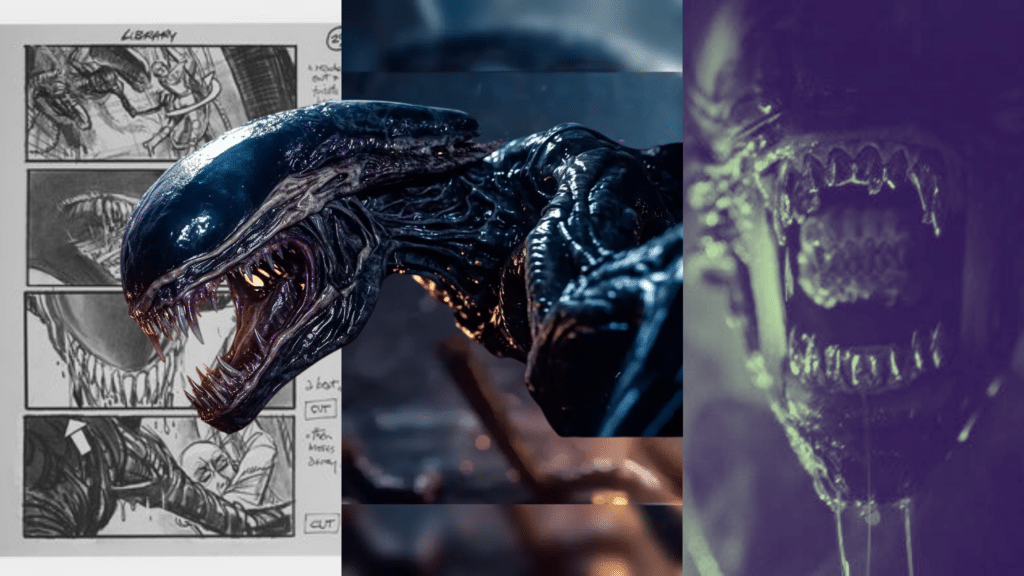
Are you a screenwriter keen to take the plunge into directing and producing? You’re
not alone as more and more writers use their skills to bring their screenplays to life.
There’s much to consider from budgets to casting, to gathering a crew together.
One way to get ahead is through storyboarding; remember, your screenplay is a
blueprint for a visual feast that will be seen on the small or big screen! Exploring how
your script will translate to the screen is a fun and crucial exercise to drive the
filmmaking process forward.
Of course, the first question is where to start. In today’s article, we’ll go on a voyage
of discovery, exploring the art of storyboarding, and who better to study than Ridley
Scott, his storyboards stuff of legend. His vision for the Alien Anthology franchise has
inspired filmmakers since the late 1970s, with the latest installment Alien: Romulus
taking movie theaters by storm.
With the help of Scott’s portfolio, we’ll take a dive into the power of storyboarding,
how Scott uses them to plan his shoots, and most importantly, how you can start
storyboarding for yourself.
It’s time to defrost from our Hypersleep Chambers and get started.
The power of storyboarding in modern filmmaking
While it’s widely regarded that a screenplay is the blueprint of an overall production,
storyboards are the visual blueprint, setting out the sequences that will thread
together.
Storyboards work chronologically, starting with the first shot, and ending with (you
guessed it!) the final shot. They show us the placement of characters, set and props,
as well as desired camera angles. They can be made up of sketches, drawings,
photographs and reference images.
A short description will accompany each frame with action, dialogue or composition
notes. Arrows will also show how camera movement and the movement of
characters in the shot connects to the next.
Storyboards have been prevalent in the film and television industries since their dawn. From Gone with the Wind (1939) to Jurassic Park (1993) and Alien: Romulus (2024), production teams have relied on storyboards to ensure efficient and clear communication between departments: everyone is on the same page (or frame!).
Even with all the advances in technology, storyboards still serve this crucial purpose, presenting the director’s physical and emotional vision to all. It’s easy to refer to, with meticulous details identifiable in one look.
This also means that any issues pre-production can be ironed out before shooting begins. It’s much simpler and cheaper to make edits to a storyboard, than orchestrate reshoots. Storyboards, even for a short film, can save a ton of money.
Behind the Scenes: Storyboarding in Alien: Romulus
Ridley Scott’s storyboards are revered in the industry, more commonly referred to as “Ridleygrams”. They have their own distinct style, harking back to the traditional comic book style, using the ink and pencil medium.
Scott doesn’t just sketch out each shot, but ensures to include intricate lighting and atmospheric details, which make them almost identical to the shot we see in the theater.
Perhaps the most famous scene of Scott’s is the chest-bursting scene from the inaugural installment in the Alien Anthology franchise Alien (1979). Scott showcases the key details in the scene with color, the blood trail left by the creature a striking and shocking feature, even in these early drawings.
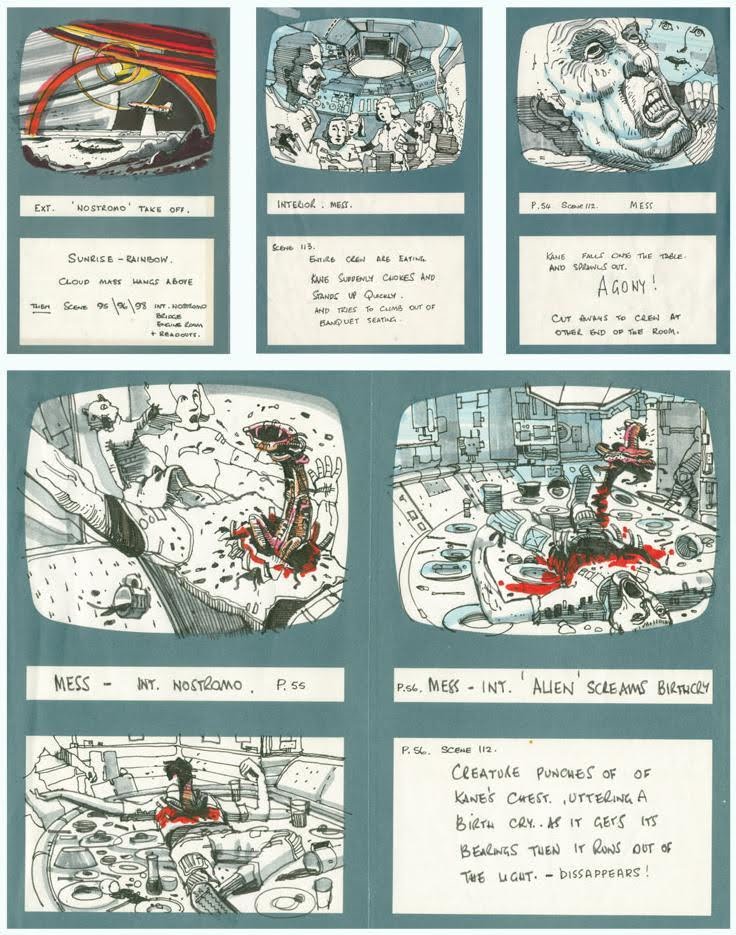
If we then compare the storyboard still with a production still from the movie, the similarities are stark.

In the original storyboard frame, we don’t just see the shot mapped out, but the complex details including emotion, aesthetic and body language. This not only gives us a clear indication of the bigger picture, but also the emotions and intentions of the characters.
By providing character indications like this, it also supports with the direction of the actors and allows them to visualize what they’ll be doing before they get in front of the camera.
While storyboard images for Alien: Romulus aren’t yet available, we can still imagine a clear picture of how they would be presented.
Take the famous full face shot of the Xenomorph that we’ve seen in most of Alien Anthology movies so far.

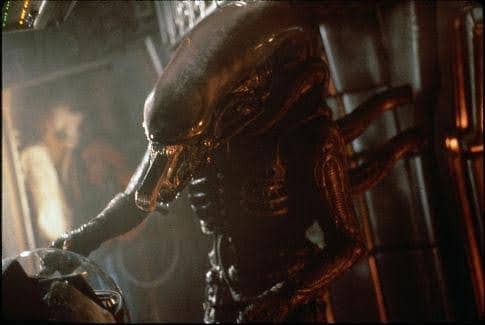
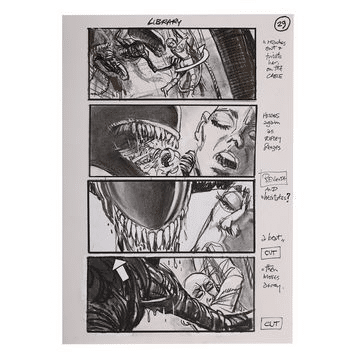
From the storyboard in Alien 3 (1992), we can see Scott’s process and how much detail truly goes into each frame of his storyboards. Figure 6 shows us just how accurately the original vision came to fruition on screen, and we can be sure that this would also be the case for Alien: Romulus.
While Scott wasn’t an integral part of Alien 3’s production, it cannot be denied that he set a groundbreaking precedent in the making of Alien, which has translated into its successors. How they storyboarded the first appearance of The Offspring in the Alien: Romulus is something I’m dying to see!
Not all storyboards need the same amount of detail as we’ve explored here. What’s important is a sure vision that will find its way on screen. You don’t need to be an artist to put together a storyboard, and there are many resources out there to support you, some of which we’ll discuss later.
Download free storyboard templates and get started on your storyboards with Celtx today.
Why storyboarding is essential for Sci-Fi
Isn’t storyboarding essential for all genres, I hear you cry? Well, yes, it is, but since we’ve spent so much time with the Alien Anthology, it wouldn’t hurt to stay a bit longer and focus on why storyboards are so important for this category of movie or TV show.
Showcasing the World
When we think of sci-fi, it’s impossible not to imagine futuristic technology, alien worlds (either friendly, hostile, or downright bloodthirsty), and intricate settings that can be difficult to describe in mere words. Here’s where storyboards provide us with a clear scope and scale of the visuals we’re trying to achieve both before and during production.
Let’s take a tour of the Nostromo with Walter Hill and David Giler, writers of the final Alien screenplay, who described the ship in the opening minutes of the movie like this:
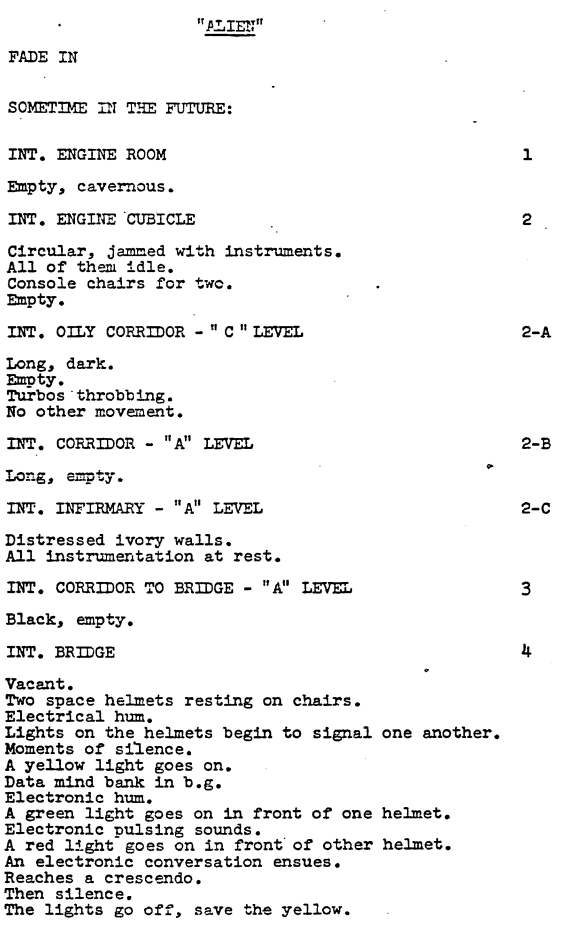
The screenplay does an effective job of summarizing what we’re seeing on screen, a clear list of what the audience should be paying attention to. Hill and Giler use short sharp sentences with key descriptions.
Check out this video, which shows the corresponding storyboards side by side with the final film version. It’s not a complete comparison, however it gives us a sound idea of the process from script to storyboard to screen, and how the technology and setting are described and presented.
SFX
Many sci-fi films rely on special effects to some degree, whether that be CGI or practical effects. Storyboarding works as a bridge between the director and the visual effects team to pre-plan where such effects may be needed, and how they’ll interact with the actors and environments.
Coordinating Large Teams
All movies need teams behind them, but the sheer scale of sci-fi productions demands huge scale teams in countless departments. From set design, costume, visual effects to sound, storyboards are a common visual reference for everyone. They help teams align to ensure each shot is filmed as it should be.
Budgeting and Time Management
Such teams and the resources they need carry heavy price tags, especially when effects and elaborate sets are involved. There is no such thing as a bottomless money pit! Storyboards are crucial for producers and directors in identifying key scenes that need extra attention, while also streamlining less critical scenes to avoid overspending.
Previsualising Action Sequences
Most sci-fi movies aren’t complete if there’s no hair-raising space battle or chase through a new plane of reality. Storyboards help break down these fast and detailed sequences, shot by shot, ensuring clarity in action, as well as camera angles, movements and pacing.
Story Consistency
With multiple plotlines, jumps in time and space all thrown in with futuristic technology, sci-fi narratives quickly become complex: it’s only in their nature! Storyboarding tames the beast, maintaining coherence and clarity on where a scene fits into the overall story.
Getting Creative
As the Alien Anthology has proven time and again, sci-fi thrives on pushing boundaries. Through storyboarding, filmmakers can experiment with different visual ideas, camera techniques, and special effects before committing to them in production, saving a whole load of time and effort.
Now that you’ve woken yourself up from your Hypersleep, had a coffee and a stretch, it’s time to steer the ship home and start creating your own storyboards. That’s if no Xenomorphs have decided to join us. No? Great!
Comparing storyboarding software
If, like me, you’re not a master with a pencil and paper, there is a super futuristic sci-fi way to develop your own storyboards. Well, not really, but there is software available that can help! Here are some of our favorites:
Boords
Priding themselves on their drag and drop feature, Boords allows you to skip the drawing and focus on creating. With collaborative work options, it’s used by filmmakers, animators and production teams alike, allowing users to add panels, pre-loaded elements, or to upload their own images to use within the program.
Users can work independently or collaborate within the Cloud, saving time.
Boords offers a variety of pricing packages, from Individual all the way up to Powerhouse, both monthly (starting at $29 per month) and yearly (starting at $25 per month).
Storyboard That
Geared more towards the education sector, Storyboard That offers similar resources to Boords, allowing students and new filmmakers to fully customize pre-existing assets from their extensive library. If you’re struggling with ideas for your screenplay, their story starter tool and pre-designed templates could be exactly what you need to get your story off the ground!
Users have utilized Storyboard That for comics, animations and movies, as well as marketing campaigns. Prices start at $10 per month for a single user, to $165 annually for a teacher plan.
Celtx
Yes, we are well-known for our screenwriting features, but did you know that we also offer free printable storyboard templates to accompany your screenplay? Create single shots and add key details, just like Ridley Scott!
It’s OK if you don’t fancy picking up your pencil, as Celtx offers a large library of designs and images. As well as placing your chosen asset within a frame, you can select and layer images to create unique backdrops, props and characters.
You can also upload your own images to complement the library – the best of both worlds!
When you’re done creating your action-packed, mind-racing storyboard, why not try out Celtx’s storyboard player? Press play and watch your storyboard move through your frames. You’ll see your movie truly take shape, and easily spot any issues you need to iron out.
Whether you want to start with the written word or the sketch, Celtx is here to guide you throughout the whole process.
To get started with Celtx Storyboarding, check out this article.
So, it’s time to land back on Earth (hopefully) and debrief.
Storyboarding is an invaluable tool that bridges the gap between script and screen, especially in the sci-fi genre. Directors can clearly communicate their vision, preemptively resolve production challenges, and maintain consistency across departments. By taking inspiration from Ridley Scott’s detailed approach, we as screenwriters and filmmakers can better visualize our stories.
Whether we’re sketching by hand or using storyboarding software, we are sure to create seamless narratives, saving time and resources while enhancing creativity.
Now, it’s time to get started on bringing your own vision to life. Watch out for those face huggers!

